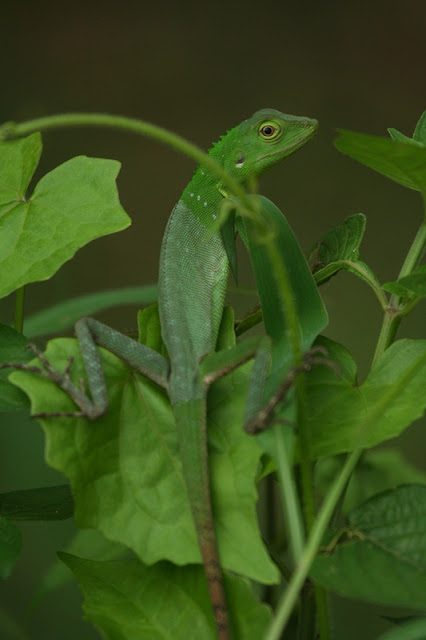After Danum, it was back to Kota Kinabalu for a night, and then a flight to Sandakan and on to Sepilok for a couple of nights. Sepilok is famous for two things: the Orang Utan Rehabilitation Centre (of which more later) and the Rainforest Discovery Centre with its canopy walkway, renowned as the best place in the world to see Bornean Bristlehead. I'm afraid I chose a lie in rather than dawn on the canopy walkway, so didn't find any Bristleheads... but it was a nice place to sit and watch the world go by, with Giant Squirrel, Rhinoceros Hornbill and a pair of displaying Crested Goshawks overhead.
Bumped into a few nice reptiles, starting with a Sumatran Cobra on the track as I arrived at my guesthouse, and a couple of cool lizards: the colourful Green Crested Lizard, and a handsome, stripey and, as it turns out, endemic Bornean Striped Tree Skink.
Walking between the RDC and the Orang Utan centre, I passed a small group of weaver nests, four in total, all containing chicks and being visited by adults carrying food. Nice enough... except, according to Susan Myers' field guide to the birds of Borneo, there are no weavers on Borneo. Well... there are now. A population of Baya Weaver was first noticed in neary Sandakan in 2007, and they are obviously doing well: as well as this population, I also noticed nests at a couple of places along the roadside between Sepilok and Sandakan airport.
And so to the main attraction, the Orang Utan Rehabilitation Centre. Here, rescued orang utans, often rescued pets or animals orphaned or dispossessed through land clearance for palm oil plantation, are soft-released back into the wild, with regular feedings in the morning and the afternoon each day.
I chose to visit for the afternoon feeding, having been warned that the morning was 'busier'. I'm sure the centre does great work, but the handful of animals who came in for food left me feeling rather sad. One young(ish) male took exception to the presence of a male Long-tailed Macaque and the two had a noisy, violent stand off, coming to blows several times. Meanwhile, a rather depressed looking little female sat quietly munching through over-ripe bananas on the food platform. Back in the carpark, another young female was, most incongrous of all, drinking from the gutters on the roof of the visitor centre. Obviously, for some animals, the return to the wild isn't as easy as for others.
On the up side, there are estimated to be around 80 orang utans now living at liberty in the Kabili Sepilok Forest Reserve, most of whom don't come in for the feeding anymore, who would otherwise have been leading very sorry lives as domestic pets, or worse.









No comments:
Post a Comment